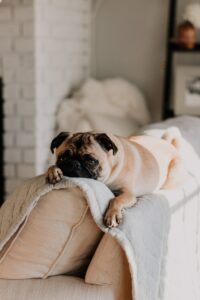
Key points
- Generally, spider bites are not dangerous for dogs. However, if a poisonous spider bites your pet, it can result in significant health issues for your pet;
- Spiders that can produce a significant amount of venom are black widow, brown widow, brown recluse spiders, and tarantulas;
- If your dog experiences drooling, vomiting, diarrhea, pale gum color, or cramping after a spider has bitten it, call the veterinarian immediately;
- If a non-poisonous spider has bitten your pet, you can use effective home remedies to treat the injury. Some of the most effective remedies include salt or baking soda mixture, turmeric powder, and potato poultice.
Just like humans, dogs can be bitten by different types of insects, including spiders. Dogs are susceptible to spider bites on body parts that are not completely covered by hair. Do you suspect your pet has been bitten by a spider? If so, don’t panic – life-threatening spider bites are very rare.
Table of Contents
Recognizing Spider Bites On A Dog’s Skin
It is not very common for dogs to experience spider bites, and when they do, there are usually no major complications. In most cases, dog owners don’t even notice that their pet has been bitten by a spider. Sometimes, however, the pet can exhibit serious symptoms that go beyond typical harmless red bite marks on the pet’s skin. One issue with recognizing spider bites is that it is very difficult to know which insect has bitten your pet unless you spot the spider on the dog’s fur or skin right away. As a result, the vet will need to review the history of the bite (where your dog got bitten, when it happened, etc.) to help the specialist accurately determine the origin of the bite.
Are Spider Bites Deadly?
Unless your dog displays severe poisoning symptoms after getting bit by a spider, you don’t need to worry too much, as spider bites are usually not deadly. However, older dogs may experience more severe reactions to bites since their immune systems are weaker.

If you are certain that a spider has bitten your dog, you need to closely monitor the pet for any poisoning symptoms for the next few days. If your dog seems to be in pain, has difficulty walking, or starts behaving unusually, go to the veterinary clinic, as the pet might require an antivenin shot. Plus, whether your dog is suffering from a spider bite, flea bite, or tick bite, it’s always a good idea to consult a vet.
Symptoms of Spider Bites in Dogs

In general, spider bites in dogs will only produce a reddish blotch or slight swelling in the location of the bite. Although it might be pretty obvious, a sudden yelp from your dog is usually the very first sign that the pet has been bitten. Some dogs are significantly bothered by the sting, so they scratch or lick their skin to relieve unpleasant sensations. Light bites from non-poisonous spiders can usually be treated with natural remedies. In some cases, spider bites could be complicated by an infection, which will be evidenced by redness, pus, pain, or warmth in the area of the bite.
Since most of your dog’s body is covered with fur, spotting spider bites on the dog’s skin is not an easy task. Even if a venomous spider has bitten your pet, you may notice the first signs of poisoning only a few days after your pet has been bitten.
Luckily, most spiders cannot produce significant amounts of venom. Out of thousands of spider species, there are only a few to be worried about. Black widow, brown widow, brown recluse spider, and tarantula bites can be extremely dangerous. The severity of the pet’s injury will also depend on the amount of the inoculated poison, the sensitivity of the dog’s body, and the area where the bite occurs. For example, spider bites in the pet’s mouth or nostrils can cause inflammation and make breathing difficult, even to the point of choking. Spider bites on the eyelids can also be incredibly painful. Remember that spider species vary depending on the region where you live. If there are no black widow spiders in your country, your dog can’t be bitten by one. On the other hand, if these spiders are common in your region, you need to take the necessary precautions.
Brown Recluse Spider Bite
 Generally, bites left by a brown recluse spider are painful. So your dog will definitely react to a bite from this spider by yelping or licking the affected area. A typical first sign of a brown recluse spider bite is limping. The pet might also develop blisters on the skin over time. According to Brian Roberts, DVM, a board-certified veterinary critical and regional medical director for VCA Animal Hospitals, venom emitted by the spider helps it to digest its prey. Thus, when a pet is bitten by this spider, some of its muscle cells and skin will die, causing tissue damage. In most cases, the location of the bite will become swollen with the color of the lesion changing from pink to darker red or black and then to white as venom progresses outward. Other symptoms may include vomiting, lethargy, and reluctance to put weight on the affected limb.
Generally, bites left by a brown recluse spider are painful. So your dog will definitely react to a bite from this spider by yelping or licking the affected area. A typical first sign of a brown recluse spider bite is limping. The pet might also develop blisters on the skin over time. According to Brian Roberts, DVM, a board-certified veterinary critical and regional medical director for VCA Animal Hospitals, venom emitted by the spider helps it to digest its prey. Thus, when a pet is bitten by this spider, some of its muscle cells and skin will die, causing tissue damage. In most cases, the location of the bite will become swollen with the color of the lesion changing from pink to darker red or black and then to white as venom progresses outward. Other symptoms may include vomiting, lethargy, and reluctance to put weight on the affected limb.
Black Widow Spider Bite
A black widow spider bite in dogs typically doesn’t result in any sort of local reaction or red bump. However, later symptoms will include muscle pain and spasms, seizures or paralysis, difficulty walking, and tremors since a black widow’s venom affects the dog’s nervous system. The bite might also be accompanied by symptoms such as drooling, vomiting, or diarrhea. A black widow bite can cause death if left untreated. Smaller-sized dogs are more likely to experience serious symptoms.

Brown Widow Spider Bite
Black widow and brown widow spiders are very similar to each other. However, brown widows are significantly less aggressive. They bite only when agitated. You can recognize a brown widow bite by symptoms like bleeding, cramping, lethargy, and bruising around the bite area.

Tarantula Spider Bite
Tarantula bites are typically very painful. Dogs often try to eat these spiders, and if swallowed, a tarantula can irritate your pet’s mouth and cause oral pain. The hair of the tarantula can also cause drooling or vomiting.
Spider Bite Outcomes
Most venomous spider bites will be accompanied by symptoms such as “drunk walking,” changes to the pet’s heart rate and blood pressure, whining, or obvious distress. In the most severe cases, the dog can go into shock and die. Black widow bites cause most fatal outcomes. The brown recluse bites, in turn, often cause necrosis in the area of the bite.
Since all these symptoms can also signify other health conditions in dogs, pets are often not diagnosed immediately. Plus, a small percentage of dogs will suffer from an allergic reaction to stings. In the most severe cases, this can lead to anaphylactic shock, a veterinary emergency that requires immediate attention.
If you suspect that any of the spiders mentioned above has bitten your dog, don’t hesitate and head to your veterinarian for life-saving care and advice. You should not attempt to treat your pet with home remedies if a venomous spider has bitten it.
Dog Spider Bite Treatment
Veterinarians generally treat minor spider bites symptomatically by providing pets with pain relief medication and supportive care. In addition, your vet will typically collect blood samples and monitor the pet’s condition as time goes on. He also can administer anti-itching medications such as steroids. The specialist can also give your pet an e-collar to keep it from scratching and licking the affected area.

Severe poisoning, however, may require medication to stop muscle contractions, counteract the necrotizing effects of the poison, or lower blood pressure. Supportive care may include surgically removing damaged tissue.
The vet may also prescribe antibiotics, antiseptics, and antihistamines to the dog to prevent secondary infections. Plus, wounds resulting from a brown recluse bite often need bandaging.
An antivenom for black widow bites is available on the market, but it is rarely used to treat pets due to its short shelf life, high cost, and the relative rarity of bites.
Home Remedies For Spider Bites on Dogs
If there are no poisonous spiders in the area you live, arachnid bites will usually result in slight swelling and itching at most. Start by examining your dog for spider bites. Spread the hair and closely inspect the pet’s skin. If you notice a red bump or bite mark, you can clean the area with regular soap and water. To help soothe the irritation, try washing your pet with a soothing oatmeal shampoo from a local pet store.
However, if you believe the bite is infected, you need to notify your veterinarian. Either way, keep an eye on the dog in case other symptoms appear or if the existing symptoms worsen. In addition, watching your pup for side effects is vital to rule out a bite by a venomous spider.
Baking soda
You can speed up the healing process by applying a mixture of baking soda and water to the area that a spider bit.
Salt

Salt is great for venomous bites; however, you should use it only after a consultation with your vet. Mix a bit of table salt with lukewarm water and pour the mixture over a clean cloth. Rub the fabric on the bite to soak up the venom.
Turmeric powder and olive oil
Mix some turmeric powder with olive oil and rub the solution on the spider bite to prevent inflammation.
Potato poultice
To reduce inflammation, you can slice up a potato, wrap it in a cloth, and apply it to the bite.
How to Avoid Future Spider Bites on my Dog?
Spiders are receding creatures, and they generally do not tend to bite pets or humans. Instead, most bites result from accidental contact, e.g., when a dog or a cat lies down on the spider, which – being fearful for its life – bites in defense.
Keep your pet away from places where spiders can lurk to reduce the chance of spider bites. Some examples of such places include canopies, unfinished basements, and piles of wood.
Another way to prevent future spider bites is to use bug spray for dogs. You can also give your dog monthly preventative medications to keep pests away.
FAQ
What are the symptoms of a spider bite on a dog?
Typical symptoms of a spider bite on a dog include swelling and redness in the affected area, itchiness, diarrhea, vomiting, drooling, muscle pain, and limping.
How do you know if your dog has been bitten by something?
Look for the common signs associated with insect bites in pets. If your dog has been bitten by something, you will typically find a red bump or a bite mark on its body. The area of the bite might itch, so your pet might try to nip at the affected area.
How do you treat a spider bite on a dog at home?
There are plenty of remedies you can use at home to help your dog with a non-venomous bite. For example, you can use a potato poultice to reduce inflammation. A homemade baking soda paste can also help to speed up the healing process. Another option is to apply a salt mixture to the wound to reduce swelling.




